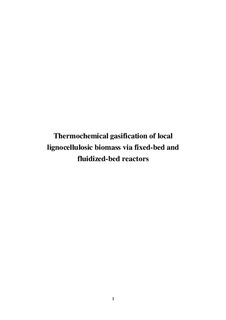| dc.description.abstract | The government in Norway aims to double the bioenergy use from 14 TWh to 28
TWh between the year 2008 and 2020. This calls for major changes in the current
energy practice and an increase in the biomass based energy applications in the
total energy mix. One effort to this end is the replacement of existing space
heating oil burners with heat from biomass combustion. However, this strategy
alone could not be able to adequately meet the target of further bioenergy
expansion. Neither will it help in achieving the Kyoto aim of reducing CO2
emission. So an alternative such as gasification could be a part of the solution.
Gasification offers many advantages, but a major concern towards this
technology is the logistics. A highly efficient gasification process would mean
very little to a technical viability if efficient biomass supply is not guaranteed.
Thus maintaining a smooth biomass supply to the conversion plant is important
in perspective of which local lignocellulosic biomass could be an interesting
option. In terms of the availability of lignocellulosic biomass, Norway is
strategically well placed due thanks to its abundant forest reserves. Norway and
forest are the two sides of the same coin which makes this country ever attractive
in developing and practicing local bioenergy research, which is partly why this
study is conducted.
The main objective of the present project was to utilize local forest crops birch,
oak and spruce and energy crops like poplar and willow as feedstocks for labscale
fixed bed downdraft gasification. Further to evaluate the gasification
performance interaction with biomass characteristics and process parameters,
experimental work consisted of series of gasification tests was optimized over a
range of air equivalence ratio (ER) between 0.19 and 0.45. The key results in
terms of gas lower heating value (LHV), gas yield, cold gas efficiency (CGE)
and carbon conversion efficiency (CCE) indicated that the producer gas obtained
from all types of woodchips species gasification exhibited a great potential to be
utilized for further downstream applications.
Besides wood, in many places of the world the lion’s share of the biomass is
contributed from herbaceous biomass. Hence this research also focused on two local herbaceous biomasses, alfalfa and wheat straw (in pellets) from Spain and
one local herbaceous biomass common reed (in briquettes) from Norway for
investigating gasification via two fluidized bed configurations being pilot-scale
and lab-scale, and one fixed-bed downdraft gasifier respectively. Pilot-scale 4.7
kg/h air-blown gasification of sole alfalfa pellets was carried out at a variable ER
between 0.25 and 0.30. The resulting bed temperature was ca 780 C and the
maximum producer gas lower heating value (LHV) was ca 4.2 MJ/Nm3 which
suits for combined heat and power application. Pilot-scale test also yielded
producer gas composition rich in H2 composition (around 13 % dry basis vol.),
indicating the potential of this gas to be utilized for hydrogen production.
In addition to the pilot-scale tests, a series of lab-scale fluidized bed gasification
on alfalfa and wheat straw pellets were conducted for a wide range of ER (0.20-
0.35) achieved by varying both fuel and air input. The optimized gasification
performance attained for the two feedstocks differed in respect to the operational
ER with a higher ER (0.35) for alfalfa and a lower ER (0.30) for wheat straw
respectively. At the optimum condition, the gas produced from both the
feedstocks exhibited a good LHV value above 4.1 MJ/Nm3 which can be
recommended for engine or, turbine application. However, owing to the poor H2
composition of 4 %, this technology may not suit downstream H2 production.
The fixed bed gasification on common reed briquettes on the other hand is a very
recent addition to the current project which is not fully developed yet. Therefore
the preliminary results obtained from a solitary test run were not representative.
The measured parameters so far indicated that the gas LHV, bed temperature and
ER range of 2.9 MJ/Nm3, 498 C and 0.35-0.86 respectively can be achieved.
Last but not the least, a techno-economic modeling considering a producer gas
generator in a 100 % renewable energy hybrid plant was performed for a
standalone household in Grimstad by using HOMER (a commercial hybrid
energy optimization tool). The results showed that producer gas generator
together with the other renewable energy options is capable of fulfilling the
annual electricity demand of a remote household with a constraint of a producer gas price less than 0.1$/Nm3. This system also provided environmental gain
worth ~22,000 kg/year of CO2 equivalent savings.
All in all, the influence of diverse local biomass feedstock on diverse gasification
techniques is proved to be feasible in aspects of technology, economy and
sustainability. | nb_NO |

